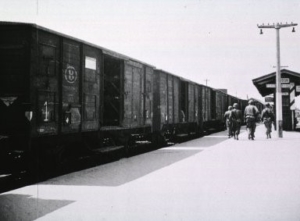1894-1902: AMBULANCE MASS TRANSIT
Mass transit use for emergency medical provision
In the late 19th century cities, including Bahia, Brazil and St Louis, Missouri, United States started using trolley cars on their tram network, which were designed to act as ambulances, transporting the sick and injured. The trolley cars in Bahia included a fumigating compartment and a two-bed work area for nurses. The design of the tram network in St Louis allowed the ambulance streetcar, introduced in 1894, to reach all 16 infirmaries in the city.[19]

A much later example of an ambulance train. First ambulance train in France, exterior, showing litter cars circa 1940, in the public domain courtesy of the National Library of Medicine
In Germany, in 1902, a civilian ambulance train was introduced (building on the use of trains during military conflict) for use during railway accidents. It housed a mobile operating room and eight stretchers. Railroad employed surgeons lived near the railway station where the ambulance train was stationed, and were summoned to urgently attend in the event of an emergency. The train had priority over the tracks, with all other trains obliged to give way.[19]
***** References:
- Barkley, Katherine T. 1990. “The Ambulance”. Exposition Press. ISBN 0-682-48983-2
- Kuehl, Alexander E. (Ed.). Prehospital Systems and Medical Oversight, 3rd edition. National Association of EMS Physicians. 2002 . @ ch. 1.
- Higginbotham, Peter (October 2005). The MAB Land Ambulance Service . Retrieved on 2007 – 06-02 .
- St. John Ambulance in the Industrial Revolution . St John Ambulance UK. Retrieved on 2007 – 06-16 .
- St John Ambulance First Aid Cover for Events . St John Ambulance UK. Retrieved on 2007 – 06-02 .
- History of Queensland Ambulance Service . Retrieved on 2007 – 06-16 .
- The Straker-Squire 1905 Ambulance . Retrieved on 2007 – 06-05 .
- McCall, Walter MP. 2002. “The American Ambulance”, Iconografix
Submitted to NEMSM June 2007 by Wikipedia (accessed by KPR, June 2007)
